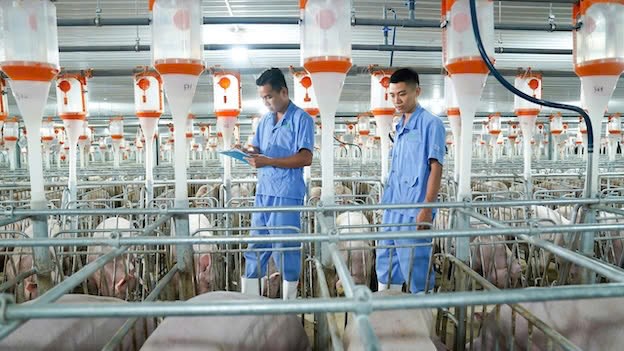Deputy Minister of Agriculture and Environment Phung Duc Tien has just signed a document to the Prime Minister proposing to allow the implementation of a pig farming model in high-rise buildings in Vietnam. Accordingly, two enterprises, BAF Vietnam Agricultural Joint Stock Company and Xuan Thien Thanh Hoa Joint Stock Company, previously submitted a proposal to implement this model.

In particular, BAF Vietnam Agricultural Joint Stock Company has strategically cooperated with Muyuan Group, China, the world's largest pig farming unit, promoting the multi-storey pig farm model to propose a smart 6-storey pig farm complex project in Tay Ninh. The project has a scale of 64,000 breeding pigs, producing 1.6 million commercial pigs/year; the total estimated investment is more than 12,000 billion VND. It is expected that after the project is completed and put into operation at full capacity, it can bring BAF from 12,000 to 13,000 billion VND in revenue per year, the expected payback period is from 5 to 5 years.
The Ministry of Agriculture and Environment shows that China has implemented more than 2,000 high-rise pig farming models with nearly 4,500 buildings, providing about 2.65 million breeding pigs and more than 30 million pigs each year. These farm chains apply smart technology such as AI, blockchain, IoT, automation and real-time monitoring sensors to analyze data, warn of epidemics and regulate nutrition for each pig.
A highlight of the model is an effective environmental treatment system: wastewater and emissions are treated with 4-layer air filtration technology to help remove more than 95% of odor; livestock waste is converted to serve the production of organic fertilizers. Thanks to that, the model ensures strict biosafety and disease control.
In addition, the high-rise model helps use land 4.3 times more effectively than traditional livestock farming and saves human resources, a worker can monitor up to 2,000 pigs. This condition is very consistent with the current trend of land fund reduction in the provinces of the Mekong Delta and the northern mountainous region.
According to the Ministry of Agriculture and Environment, the Law on Livestock, Resolution 57-NQ/TW and the project to develop the barn industry by 2030 all encourage the application of high technology in livestock farming, and at the same time, TCVN 14209:2024 standard has officially regulated multi-storey pig farms in Vietnam. However, most farms are still operating according to the traditional model of small scale, vulnerable to epidemics and lacking economic efficiency.
Pork farming is also a key livestock industry in Vietnam, accounting for 62-65% of total meat output of all kinds. In 2024, the output of steamed meat exported to the cage will reach nearly 5.2 million tons, ranking 6th in the world. Vietnamese pork consumption ranks fourth in the world.
When the African swine fever epidemic occurred, more than 9 million pigs were destroyed, causing a loss of more than 30 trillion VND. In April 2020, the price of pork exported at the bell has increased to 105,000 VND/kg at times, directly affecting the domestic CPI to increase by 6.73%. Therefore, when the supply and price of pork change, it has directly affected economic and social development and the domestic consumption CPI.











